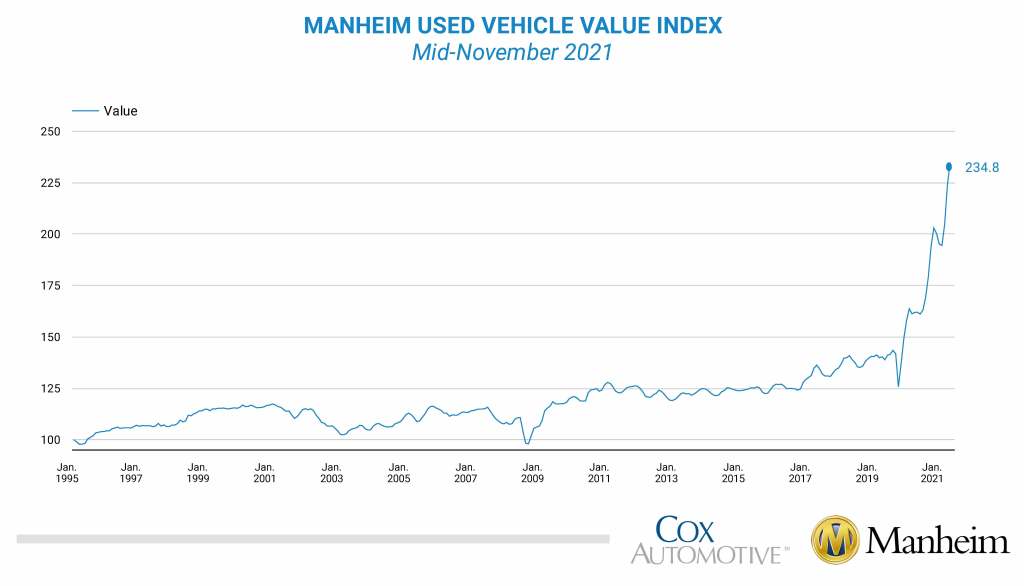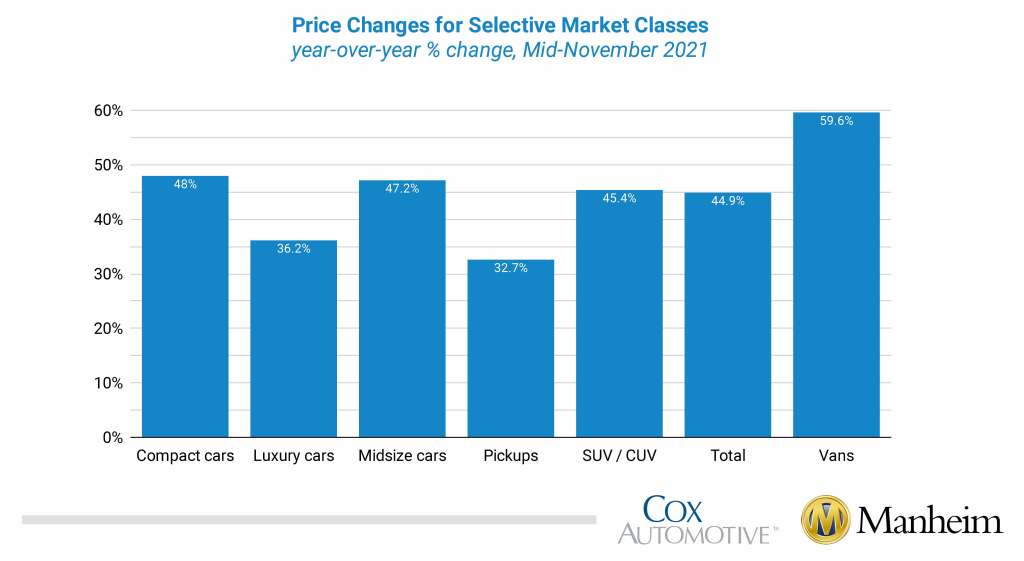Data Point
Wholesale Prices Rise Halfway Through November
Wednesday November 17, 2021
Wholesale used vehicle prices (on a mix-, mileage-, and seasonally adjusted basis) increased 4.9% in the first 15 days of November compared to the month of October. This brought the Manheim Used Vehicle Value Index to 234.8, a 44.9% increase from November 2020. As was the case in October, some of the monthly increase is a result of the seasonal adjustment, as November typically sees above-average vehicle depreciation and therefore used price declines. The non-adjusted price increase through mid-November was 2.6%.
Manheim Market Report (MMR) prices increased over the first two full weeks of November at a decelerating pace. The Three-Year-Old MMR Index, which represents the largest model year cohort at auction, experienced a 1.9% cumulative increase over the last two weeks. Over the first 15 days of November, MMR Retention, which is the average difference in price relative to current MMR, averaged 101%, which indicates that valuation models are not keeping pace with the increase in market prices. The average daily sales conversion rate of 65.2% in the first half of November declined relative to October’s average of 66.6% but remains elevated for this time of year. The latest trends in the key indicators suggest wholesale used vehicle values will likely see smaller gains in the second half of the month.
On a year-over-year basis, all major market segments saw seasonally adjusted price gains through the first 15 days of November. Pickups had the smallest year-over-year gains, vans had the largest at 59.6%, and both non-luxury car segments outpaced the overall industry in seasonally adjusted price growth. Compared to October, midsize cars had the smallest growth in the first half of November, while vans had the largest gain.
Used supply normalizes. Using a rolling seven-day estimate of used retail days’ supply based on vAuto data, we see that used retail supply is now at normal levels at 43 days. Wholesale supply has also improved but remains below normal at 20 days for the most recent seven-day period when normal supply is 23.
Rental risk pricing declines month over month. The average price for rental risk units sold at auction in the first 15 days of November was up 26.6% year over year. Rental risk prices were down 13% compared to October. Average mileage for rental risk units in the first half of November (at 73,011 miles) was up 35% compared to a year ago and up 20% month over month.
Auto loan performance continues to deteriorate. Auto loan performance deteriorated again in October. With government support fading, credit performance is starting to normalize from historically low delinquencies and defaults. 60-day+ delinquencies increased in October for the fifth month in a row and were up 4.6% year over year. In October, 1.33% of auto loans were severely delinquent, which was an increase from 1.28% in September and the highest severe delinquency rate in 7 months. Compared to a year ago, the severe delinquency rate was 5 basis points higher. In October, 5.05% of subprime loans were severely delinquent, which was an increase from 4.83% in September and the highest severe delinquency rate in 8 months. Compared to a year ago, the subprime severe delinquency rate was 41 basis points higher. Loan defaults increased 6.7% in October from September but were still down 0.3% year over year. Even with loan performance normalizing, auto credit access expanded in October. The Dealertrack Auto Credit Availability Index measured auto credit as looser in October compared to February 2020 before the pandemic began for all types of loans and all types of lenders.
The complete suite of monthly MUVVI data for November will be released on Tuesday, Dec. 7, 2021, the fifth business day of the month as regularly scheduled. If you have any questions regarding the Index, please contact the Cox Automotive Industry Insights team at Manheim.Data@coxautoinc.com.
The next Manheim Used Vehicle Value Index quarterly call is scheduled for Friday, Jan. 7, 2022. Register to attend.


